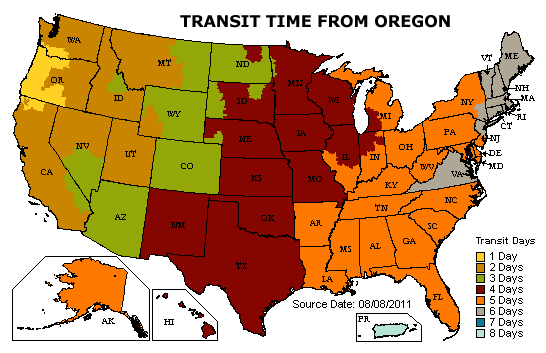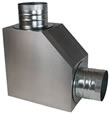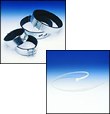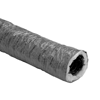- residential
- Ventilation Accessories
- Silencers and Backdraft Dampers
- Fantech LD Silencers
Fantech LD Silencers
Fantech LD Silencers are typically used for kitchen exhaust systems. When attached to an inline or remote fan, the LD silencer dramatically reduces the sound traveling through the duct.
Two silencers can be used together in installations where noise reduction is critical. For the most effective noise reduction, the silencer should be fitted immediately behind a fan or bend. The internal insulation thickness is 2 inches.

Stocked in both Oregon and New York state. See transit maps below.


Some products might ship from multiple warehouses.
| Do you have questions about the products on this page? Click on the ? image on the left or this link to ask us your questions! |
| #1 | Q: Im looking to install one of these on a rigid duct heat run going to a bedroom to reduce furnace noise coming through the register. What hardware do I need to install these? Thank you. A: If the rigid duct is the same size as the silencer ends then no additional hardware needed. Use sheet metal screws to connect the duct and the silencer and seal well. Asked on 2025-01-03 by Logan |
|---|---|
| #2 | Q: How high of heat can this be used for ? A: Standard residential applications. Max of 140 F airstream temperatures is typical in residential. Asked on 2024-03-29 by Gregg |
| #3 | Q: Considering the 4 silencer to try and quiet the motor and turbulence noise from a 70 cfm erv drawing air through rigid PVC pipe as duct. Should the silencer be mounted closer to the fan motor or closer to the intake, or does it matter. Would changing the rigid duct to insulated flex duct offer a similar noise reduction or would the silencer be more effective? A: It does not matter where you mount it as long as the silencer is between the ERV and where you are listening to the noise. Flex duct offers similar noise attenuation but you need a much longer section to get the same effect. Flex duct is also more restrictive to airflow. Asked on 2024-01-18 by Theo |
| #4 | Q: What is the about 500 cfm exhast air individual pressure drop in LD8 silencer and CSL elbow duct silencer. A: Both of these have the same inner diameter as the 8 inch duct. The CSL will have roughly the pressure drop of a 90 degree elbow. The LD 8 will have less pressure drop since its straight. Our calculator tells me approx 0.02 inches of pressure drop for the LD 8 at 550 CFM. Asked on 2022-05-29 by Dan |
| #5 | Q: Residential - I am thinking about pulling the motor in my hood over the cooktop. When the motor is on high, it is way too noisy. I want to install an inline motor in the attic with a silencer. I assume some small amount of grease gets past the metal filter attached to the hood. I can only imagine that some of the grease sticks inside the silencer. Can the silencer be soaked in hot water with a degreaser or Oxy Clean once a year without degrading the silencer insides? A: The silencer is lined with Mylar so that grease in the airstream does not soak into the silencing material. Its not meant to be soaked or steam cleaned since that is typically never done in a residential kitchen exhaust. Asked on 2022-02-05 by Kenn |
| #6 | Q: Would this reduce noise for a kitchen hood with internal fan? A: No. This is for remote fans and installed between the fan and the hood. Asked on 2022-01-06 by Lisa |
| #7 | Q: I am installing this in short run of Kitchen ducting, is there an advantage in making the run of duct longer for sound absorption? to attach to hard ducting do you just put a screw through the duct into the neck of the silencer behind the gasket? A: You are presumably using rigid metal duct so no advantage to extend. The metal duct does not absorb any sound. Yes, slide the duct over the silencer lip, put in a couple of screws and tape/seal the connection. Asked on 2021-03-16 by Kirk |
| #8 | Q: Any reason why you would not suggest using this product with a forced air heating/cooling duct system? A: No reason. Fine for that use. Asked on 2020-11-18 by Jeff |
| #9 | Q: How does this work? What mechanism reduces the sound? A: Its a muffler. The inner surface is perforated metal, mylar and sound absorbing glass insulation. Asked on 2020-05-09 by Kevin |
| #10 | Q: How does one cut this to a length to match the run? A: It does not get cut. Its installed as 1 piece. You can add additional silencers if required for further noise reduction. Asked on 2020-04-08 by Ganesh |
| #11 | Q: Does this silencer come with the clamps to attach to flex duct? A: No clamps included. Ideally you would slide the duct over the flanges, tape it and then use a zip tie over the tape for a mechanical connection. Asked on 2019-12-28 by GCM |
| #12 | Q: Is there an advantage to combining BOTH an inline silencer AND a 90 degree elbow silencer? Im thinking of using a wall mounted exterior centrifical fan. 8 round duct. The vertical run is about 5 and the horizontal run is about 7 including 1 exterior brick wall. Im concerned about noise and also grease buildup in the system. What are your thoughts? A: You will get some benefit in doubling up on the silencers. If space and budget allows, there is no downside. In a residential kitchen, grease buildup should not be an issue. Make sure your intake has a grease screen or filter of some kind. Asked on 2017-11-28 by Chicago |
| #13 | Q: Can this be installed vertically? Is there any benefit of vertical or horizontal installation? A: Yes, it can. The orientation does not make any performance difference. Asked on 2017-02-28 by Steven |
| #14 | Q: RE #3 below, Given 18 Ft (+90* elbow) from Kitchen Hood to outside wall, should Fan & Silencer be close to Hood or outside wall..? e.g. - best configuration (location & spacing) for quietest operation. How much difference in noise reduction does location of fan/Silencer make A: I would put the fan further away from the hood and the silencer relatively close to the fan. Typically installation factors such as joists, power availability, access, etc govern fan location. Remember the silencer has to be between the hood and the fan. Asked on 2017-01-01 by Rob |
| #15 | Q: What is the pressure drop on the silencer for 6 duct? A: The inside diameter of the silencer is same as the duct (virtually not size reduction) so the pressure drop should be the same as a similarly long piece of duct - very small. Asked on 2016-11-03 by DS |
| #16 | Q: What are the outer diameters and lengths of your LD 4 and LD 5 models? A: LD 4/5s are 23-5/8 inch long. LD4 outside diameter is 8 inches and the LD5 9 inches. Asked on 2016-04-04 by Steve |
| #17 | Q: Does the silencer get mounted before or after the fan unit? A: The silencer gets mounted between the kitchen and the fan --- between the space where you are trying to reduce sound and the fan which makes the sound. Asked on 2015-05-07 by David |
| #18 | Q: What are the weights of these silencers? Im specifically interested in the LD-8 unit. A: Ships at 18 pounds, but my guess is closer to 12-15. Asked on 2014-01-28 by Mike |
| #19 | Q: Ok to use for kitchen exhaust? A: Yes, for residential use. Commercial kitchens have special requirements. In residential use since you are using rigid duct these silencers make a tremendous difference to the noise transmitted from the fan. Asked on 2013-03-28 by Nick |
Related Products
HVACQuick CSL Series Elbow Duct Silencer
Used to reduce the noise of any inline exhaust fan (kitchen exhaust systems). The rigid elbow provides an efficient turn and at the same time maximizes sound absorption.

Fantech FC Duct Clamps and Cable Ties
FC stabilizing mounting clamps and plastic cable ties.

Fantech FIDT Flexible Insulated Duct
Flexible insulated duct is convenient, leak tight, and is the key to quiet bathroom ventilation systems.

-
residential
- AirFlow Boosting
-
Grilles, Registers & Louvers
- Learn about solutions
- Bar Linear Grilles
- Grilles - Rectangular
- Grilles - Round
- Baseboard Registers
- Curved Blade Grilles
- Decorative Grilles
- Filter Grilles
- Perforated Flat Custom Grilles
- Perforated Flanged Custom Grilles
- Plastic Grilles & Registers
- Round Perforated Flat Grilles
- Slot Diffusers & Returns
- Spiral Duct Diffusers
- Spot Diffuser Nozzles
- T-Bar Plastic Supply Diffusers
- T-Bar Metal Supply Diffusers
- T-Bar Return Grilles
- Wood Grilles
- Louvers
- Dampers
- Access Doors
- Air Handlers
- Attic Fans & Vents
- Bathroom Ventilation
- Booster Pumps
- Crawlspace-Radon Ventilation
- COVID-19 Mitigation
- Condensate Pumps
- Dryer Boosting
-
Fans
- Learn about solutions
- Inline Fans
- Inline EC Fans
- AV Closet Cooling
- Basement Ventilation
- Ceiling Mounted Bath Fans
- Crawlspace Ventilation
- Destratification Fans
- Draft Inducers and Chimney Fans
- Dryer Booster Fans
- Explosion Proof Fans
- Exterior Exhaust Fans
- Garage Ventilation
- Hydroponics Fans
- Propeller Fans Direct Drive
- Radon Fans
- Room-to-Room and Register Boosters
- Rotary General Purpose Fans
- Timers
- Exhaust Fan Controls
- Filter Boxes
- Filters & HEPA
- HRVs and ERVs
- Floor Heating
-
Indoor Air Quality - IAQ
- Learn about solutions
- HEPA Filtration
- Inline Filter Boxes
- Air Exchange Ventilators
- Air Inlets & Fresh Air Kits
- Air Purifiers
- Airflow Regulators
- Active Dampness Control
- Dehumidifiers
- Duct Heaters - Electric
- Energy Recovery ERVs
- Filter Change Alert
- Garage Ventilation
- Humidifiers
- Heat Recovery HRVs
- Pressure (Air) Balancing
- Radon Fans
- Supply Air Ventilators
- Thermostats
- UVC Lights and Systems
- Zoned Exhaust Systems
- Kitchen Exhaust
- Makeup Air
- Mini-Splits & Heat Pumps
- Pumps & Instant Hot Water
- Solar Air Heating
- Tankless & Flue Venting
- Thermostats and Fan Controls
- Title 24 Products
- Whole House Fans
- Wildfire Smoke Control
-
Ventilation Accessories
- Learn about solutions
- Access Doors
- Air Dampers
- Air Inlets & Fresh Air Kits
- ASHRAE 62.2 Controls
- Attic Vents
- Current Switches
- Discharge Caps - Wall
- Discharge Caps - Roof
- Dryer Exhaust Caps
- Dryer Vent Boxes & Couplings
- Duct and Duct Accessories
- Exhaust Fan Controls
- Grilles - Rectangular
- Grilles - Round
- Louvers
- Occupancy Switches
- Pressure Switches
- Relays & Misc Controls
- Silencers and Backdraft Dampers
- Soffit Vents
- Spare Parts
- Timers
- Tools For Sheet Metal
- Y Fittings and Transitions
- Zoning and Zone Dampers
why buy from us?
We're engineers passionate about home ventilation and serious about customer service – so you can count on us for carefully-selected equipment and expert advice to ensure your project is a success from specification to installation.
Your call is answered by qualified people who will gladly discuss your project in detail, advise you professionally and never sell you inappropriate products.





